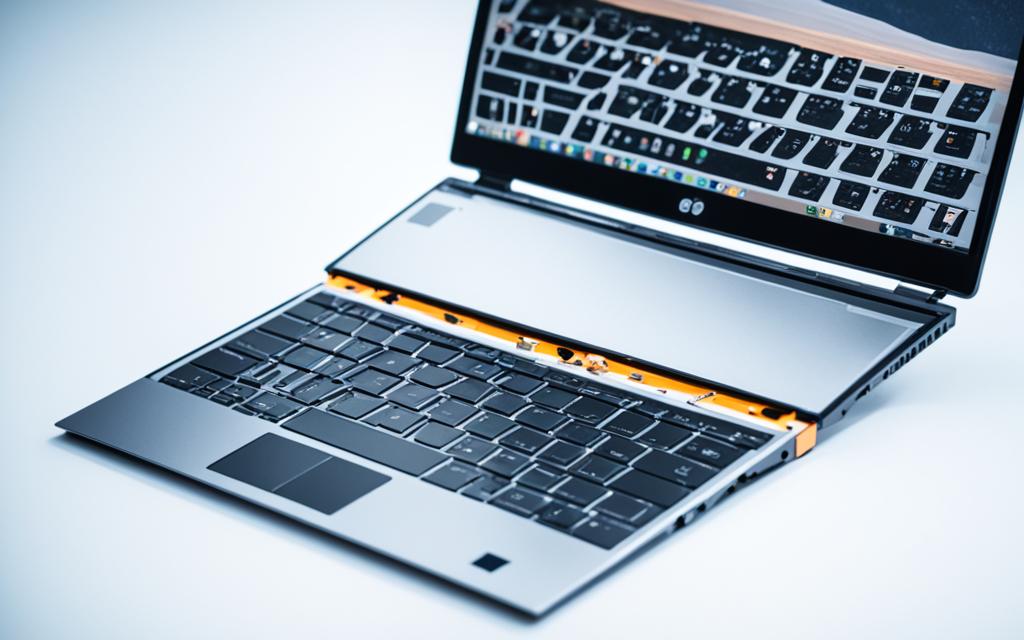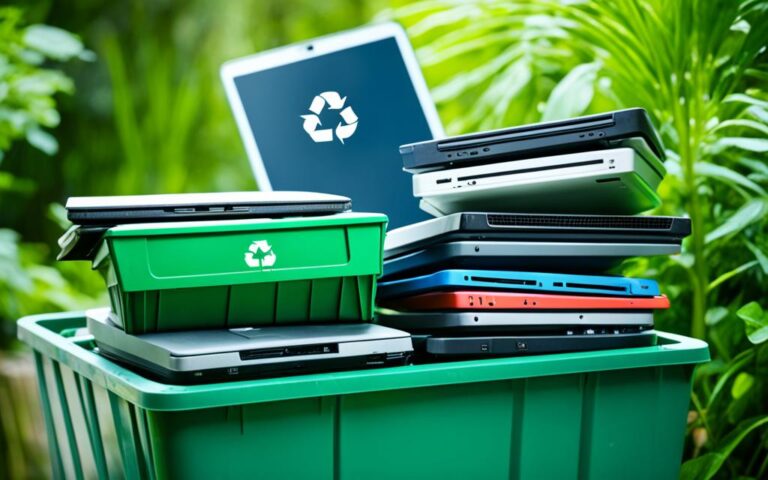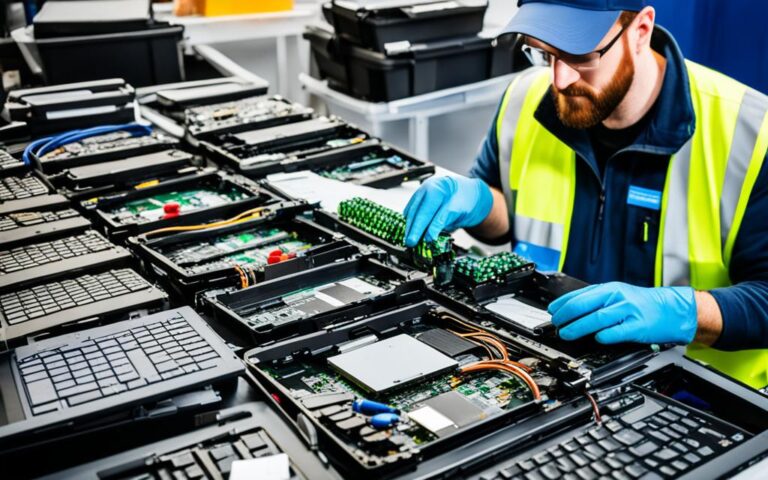Designing for Disassembly: How Laptops Can Be Made More Recyclable
When it comes to sustainable computing, recyclable laptop design plays a crucial role in reducing electronic waste and promoting eco-friendly technology. Each year, over 2 million tons of electronic waste, including laptops, are discarded in the U.S. alone without proper recycling. This results in an incomplete end-of-life process and a significant gap between consumers and recyclers.
Fortunately, a team of students from Stanford and Aalto University has developed an innovative solution. They have designed a prototype laptop that can be easily disassembled for recycling, putting the power of sustainable computing in the hands of consumers. This laptop can be taken apart by hand in less than two minutes, without any tools required. The electronic components can then be mailed to an e-cycling program, while the rest of the laptop can be recycled at home.
This groundbreaking design represents a new class of electronic products that prioritize recyclability and ease of disassembly. By incorporating such designs into laptops and other devices, we can significantly reduce the environmental impact of electronic waste and pave the way for a more sustainable future.
The Importance of Design for Disassembly
Despite the presence of takeback programs and e-waste recycling services, many consumers still discard their old electronics or let them accumulate at home. The main challenge lies in the incomplete end-of-life process and the gap between consumers and recyclers. Designing for disassembly is crucial in addressing this issue.
By prioritizing recyclability and ease of disassembly, laptops and other electronics can be made more sustainable. The Stanford-Aalto design team’s challenge was to create a fully recyclable consumer electronic device, which led to the development of their recyclable laptop prototype. The team used Autodesk design software to explore ideas, consider materials, and work through various design problems and iterations. This project highlights the importance of incorporating sustainability into the design process and creating products that are both functional and environmentally friendly.
Closed-Loop Recycling of Laptops
Covestro, a leading supplier of engineering polymers, recognizes the importance of closed-loop recycling in creating circular economies. By implementing closed-loop systems, the plastic waste generated by discarded laptops can be reintegrated into the manufacturing process, reducing the need for virgin materials and minimizing environmental impact.
The current supply chain for recycling engineering polymers faces various challenges, including sorting dissimilar materials, dealing with incompatible coatings, and ensuring consistency in quality. These obstacles hinder the efficient recycling of laptops and other electronic waste.
In Covestro’s study conducted in collaboration with Dell Technologies, the potential for closed-loop recycling of laptops was investigated. The focus was to retain the mechanical properties of recovered plastic components when re-incorporated into new laptop parts.
The findings of the study demonstrated that it is indeed possible to achieve high levels of recycled content in laptop plastics without compromising their engineering properties. This breakthrough paves the way for a more sustainable approach to laptop manufacturing and disposal.
Education and Collaboration: Keys to Success
To fully realize the potential of closed-loop recycling, it is crucial to educate consumers about the environmental impact of e-waste and incentivize responsible disposal. By raising awareness and providing convenient solutions for recycling laptops, the volume of plastic waste can be significantly reduced.
Furthermore, collaboration between plastics suppliers and the market is essential in assessing the feasibility of closed-loop recycling and capturing devices at the end of their life cycle. This collaborative effort enables the development of effective recycling processes that maximize the value and potential of plastic waste.
Key benefits of closed-loop recycling of laptops include:
- Reduction of plastic waste in landfills
- Conservation of natural resources by utilizing recycled materials
- Promotion of circular economies by minimizing reliance on virgin materials
- Lower carbon footprint due to reduced energy consumption in production
It is through initiatives like Covestro and Dell’s study that the potential of closed-loop recycling is highlighted, showcasing the value and feasibility of reclaiming plastic waste in a sustainable manner.
| Benefits of Closed-Loop Recycling | Benefits of Closed-Loop Recycling | Benefits of Closed-Loop Recycling |
|---|---|---|
| Reduction of plastic waste in landfills | Conservation of natural resources by utilizing recycled materials | Promotion of circular economies by minimizing reliance on virgin materials |
| Lower carbon footprint due to reduced energy consumption in production |
Reclaiming Plastic Waste for a Sustainable Future
The feasibility of closed-loop recycling in laptop manufacturing signifies a significant step towards achieving a more sustainable future. By reclaiming plastic waste and incorporating it into the production of new laptops, the circular economy approach can be embraced, reducing waste and conserving resources.
Dell’s Approach to Design for Disassembly
Dell, a renowned technology company, has recognized the importance of prioritizing modularity and ease of repair in their product design. This approach stems from their commitment to making recycling and disassembly more accessible. With a growing demand for sustainable electronic devices, Dell has taken significant steps to redesign their computers and incorporate circular design principles.
The latest version of Dell’s Concept Luna exemplifies their commitment to design for disassembly. By eliminating the need for adhesives, cables, and many screws, Dell has made it even easier for consumers to take apart and repair their computers. This redesign not only enhances the modularity of the device but also promotes ease of repair, ensuring that components can be easily replaced or refurbished.
In collaboration with a micro-factory, Dell’s design team has created a device that can be swiftly disassembled by both robots and humans. This innovative approach allows for more efficient device disassembly, enabling a better understanding of which components can be reused, refurbished, or recycled. By streamlining the disassembly process, Dell promotes component reusability and contributes to the reduction of electronic waste.
Dell’s Framework computer is another remarkable example of their commitment to design for disassembly. The Framework computer is specifically designed with modular components that can be easily replaced as needed. Whether it’s upgrading the processor or replacing a faulty component, Dell empowers consumers to extend the lifespan of their devices by offering a user-friendly and repairable solution.
By prioritizing modularity, ease of repair, and circular design, Dell is at the forefront of creating more sustainable electronic devices. Their innovative approach not only addresses the growing concern of electronic waste but also highlights the importance of designing products with end-of-life considerations in mind. Through their efforts, Dell is setting an example for the industry, encouraging other manufacturers to adopt similar practices and pave the way for a more sustainable future.
| Benefits of Dell’s Design for Disassembly | Impact |
|---|---|
| Promotes component reusability | Reduces electronic waste |
| Facilitates efficient device disassembly | Enhances recycling processes |
| Enables easy replacement of modular components | Extends the lifespan of electronic devices |
The Future of Sustainable Computing
Designing for disassembly is a crucial aspect of creating more sustainable electronic devices. By prolonging the lifespan of individual components and optimizing their usage, the overall product lifespan can be extended, resulting in a significant reduction of e-waste. Circular design practices, such as modularity and ease of repair, enable consumers to easily replace or upgrade specific components without discarding the entire device. This approach aligns with the principles of sustainability and contributes to the reduction of e-waste, one of the major environmental challenges we face today.
The circular design philosophy focuses on creating products that are built to last and designed with the end in mind. By incorporating repairability, upgradability, and recyclability into the design process, electronic devices can have a prolonged lifespan, reducing the need for constant replacements. This not only saves resources but also reduces the environmental impact of electronic waste.
One example of circular design in action is the modular smartphone concept. It allows users to easily swap out individual components, such as the camera or battery, instead of replacing the entire phone. This not only extends the device’s life but also reduces the amount of e-waste generated. Companies like Fairphone and Shift are already implementing circular design practices in their smartphones, showcasing the future possibilities of sustainable computing.
“Circular design practices, such as modularity and ease of repair, enable consumers to easily replace or upgrade specific components without discarding the entire device.”
Product lifespan optimization is another key aspect of sustainable computing. By creating devices that are durable and long-lasting, we can minimize the constant cycle of buying new electronics and disposing of old ones. This not only reduces waste but also saves consumers money in the long run. Brands like Apple and Samsung have introduced trade-in and upgrade programs to encourage customers to keep their devices longer and reduce electronic waste.
The reduction of e-waste is a pressing global issue. The United Nations estimates that we produce 50 million tons of e-waste each year, with only 20% being properly recycled. By embracing circular design practices and optimizing product lifespans, we can make a significant impact in addressing this problem. Through collaborative efforts between manufacturers, consumers, and policymakers, we can create a sustainable future for computing.
| Circular Design Practices | Product Lifespan Optimization | Reduction of E-waste |
|---|---|---|
| Modularity | Durable and long-lasting devices | Minimized need for constant replacements |
| Ease of repair | Trade-in and upgrade programs | Proper recycling of electronic waste |
| Recyclability | Cost savings for consumers | Global efforts to address e-waste |
Conclusion
Designing for disassembly is a critical step in creating recyclable laptop designs and promoting sustainable computing. The successful prototypes developed by the Stanford-Aalto design team and Dell’s Concept Luna clearly demonstrate the potential for easy disassembly, component reusability, and efficient recycling. As the demand for electronic devices continues to rise, it is essential for manufacturers to prioritize circular design practices to create products that are not only functional and user-friendly but also environmentally friendly.
By designing laptops and other electronics with recyclability in mind, we can significantly reduce the generation of e-waste and minimize the environmental impact of our technology. Embracing sustainable design practices is crucial for both manufacturers and consumers as we work together towards a more sustainable and circular future.
Creating recyclable laptop designs and adopting sustainable computing practices is not only beneficial for the environment but also for the overall well-being of our planet. As consumers, we have the power to choose products that prioritize circular design and have a minimal environmental impact. By supporting manufacturers who embrace recyclable laptop designs and sustainable computing practices, we can contribute to the reduction of e-waste and the preservation of our natural resources.
FAQ
What is the importance of designing for disassembly in laptop design?
Designing for disassembly in laptop design is crucial because it allows for easier recycling and reduces electronic waste. By prioritizing recyclability and ease of disassembly, laptops can be made more sustainable and environmentally friendly.
How can laptops be made more recyclable?
Laptops can be made more recyclable by incorporating circular design principles such as modularity and ease of repair. This way, specific components can be easily replaced or upgraded without discarding the entire device, reducing the generation of e-waste.
What are the challenges in the end-of-life process for electronics?
The end-of-life process for electronics faces challenges such as the incomplete recycling process and the gap between consumers and recyclers. These challenges contribute to the accumulation of electronic waste and the improper disposal of old electronics.
What is closed-loop recycling of laptops?
Closed-loop recycling of laptops refers to the process of recycling plastic components and re-incorporating them into new laptop parts. This recycling approach aims to retain the mechanical properties of the recycled plastic components without compromising their engineering properties.
How does Dell approach design for disassembly?
Dell approaches design for disassembly by prioritizing modularity and minimizing the use of adhesives and screws in their computers. Dell’s Concept Luna eliminates the need for adhesives, cables, and many screws, making it easier to take apart a computer for recycling or component reuse.
How can circular design practices contribute to sustainable computing?
Circular design practices, such as modularity and ease of repair, help prolong the lifespan of individual components and optimize their usage. This reduces the generation of e-waste and minimizes the environmental impact of electronic devices, making sustainable computing possible.













